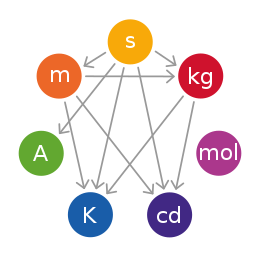
Back СИ Abkhazian SI-stelsel Afrikaans SI-Einheitensystem ALS Sistema Internacional d'Unidaz AN نظام الوحدات الدولي Arabic سيستيم عالمي د لعبرات ARY النظام الدولى للوحدات ARZ আন্তৰ্জাতিক একক পদ্ধতি Assamese Sistema internacional d'unidaes AST Beynəlxalq vahidlər sistemi Azerbaijani

The International System of Units is the standard modern form of the metric system. The name of this system can be shortened or abbreviated to SI, from the French name Système International d'unités.
The International System of Units is a system of measurement based on 7 base units: the metre (length), kilogram (mass), second (time), ampere (electric current), kelvin (temperature), mole (quantity), and candela (brightness). These base units can be used in combination with each other. This creates SI derived units, which can be used to describe other quantities, such as volume, energy, pressure, and velocity.
The system is used almost globally. Only Myanmar, Liberia, and the United States do not use SI as their official system of measurement.[1] In these countries, though, SI is commonly used in science and medicine.
- ↑ "Appendix G: Weights and Measures". The World Facebook. Central Intelligence Agency. 2013. Archived from the original on 6 April 2011. Retrieved 5 April 2013.